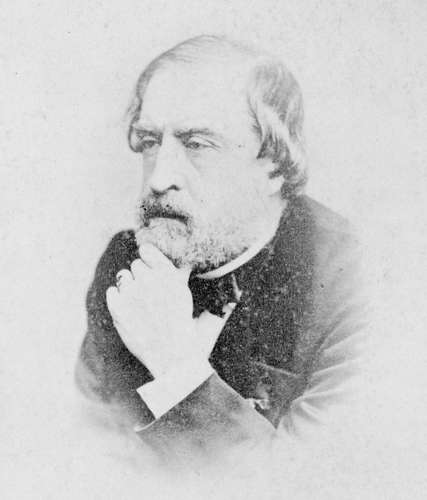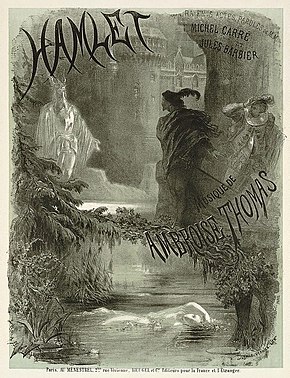
Ambroise Thomas (1811-1896), one of the most celebrated French composers during his lifetime, is relevantly unknown compared to his contemporaries. He often gets overshadowed by Charles Gounod and one of his students at the Paris Conservatorie, Jules Massenet, but Thomas is responsible for shaping the direction of French music, both as a composer and the director of the Paris Conservatorie. He netted a Grand Prix du Rome in 1832, starting his composition career that led to two dozen operas, including one of his most successful works, Hamlet (1868). How did this composer, responsible for modernizing the curriculum at the Paris Conservatorie, whose operas were as influential as Wagner, disappear and why is he making a comeback now? Well, everyone loves a good revenge story, which brings us to Hamlet. And the next question, why is there a saxophone solo in Hamlet?
Thomas was appointed as a composition professor at the Paris Conservatorie in the late 1850’s before taking over as the director from 1871-1896.[1] In order to write for the saxophone, the Conservatorie had to produce saxophonists who could play the music. With Thomas’s help, Adolphe Sax took the position of saxophone teacher at the Paris Conservatorie from 1856 until 1870.[2] This allowed composers like Thomas to write more complex solos that would showcase the full range of the instrument. In Hamlet, the alto saxophone is featured in the second act during the banquet scene where Hamlet accuses his uncle of murdering his father. Hamlet hires actors to stage a play. As the play begins, the music that accompanies them is an extensive saxophone solo. What makes this solo so memorable is the sweetness in the melody in juxtaposition to the story of betrayal. In this 2011 Croatian National Opera production, the saxophone is on stage, taking part in the play within the opera.
Hamlet diverges from Shakespeare’s original story line, but that didn’t bother the audiences flocking to the opera. The memorable arias, especially Ophelia’s Act IV mad scene keeps the opera alive in Great Britain, France, and most recently the United States. In 2010, the Metropolitan Opera House staged Hamlet for the first time in over 100 years with the help of Baritone Simon Keenlyside, whose portrayal of Hamlet riveted audiences across Europe.[3]

No grand opera is complete with a ballet, just like the play, Thomas uses the saxophone as a solo for the “Scène du bouquet.” What’s unique about the ballet is the alto saxophone is shares the solo with an E flat baritone saxophone, possibly one of the first baritone solos in opera. Check out the score for the ballet music, the “baryton” joins the alto on page 525. In current productions like the Met 2010 production of the opera, the ballet is excluded or abridged. The ballet can be performed on it’s own, and several recordings of the ballet exist, like the one below where you can hear the saxophone solo.
When Thomas needed a four handed piano score to Hamlet, he hired Georges Bizet (1838-1875) to create the reduction. At this point in his life, Bizet was a struggling composer who had difficulty getting his large scale operas and symphonies performed. It’s possible that the saxophone solo in Hamlet inspired him to write the saxophone solo in his 1872 suite, L’Arlésienne.
The next Thomas opera to include the saxophone is his 1882 grand opera, Françoise de Rimini. The opera is rarely performed, but the Act III, Airs de Ballet, has been turned into a concert piece. The alto saxophone is featured in the “Adagio” and “Habanera.” “Adagio” features the alto saxophone as a solo when the piece modulates to concert A flat. (minute 1:10 in the video below) At the end, the saxophone has a cadenza with the flute and solo violin. In “Habanera”, (minute 11:50 in the video below) the saxophone has the main melody throughout most of the piece. Without a recording of the opera, it’s difficult to understand how Thomas uses the saxophone in the opera. But in 2011, a music festival celebrating Ambroise Thomas’s bicentennial of his birthday staged a revival of Françoise de Rimini at the Opéra-Théâtre de Metz-Métrople.[4] It is possible this opera may find a new life on the stage.
Françoise de Rimini was Thomas’s last grand opera. He retired from the Paris Conservatorie in 1894. He spent the last few years of his life fighting against the new French style of music, but his conservative tastes were overshadowed by Impressionists. The Impressionists turned their backs on the formalism that Thomas represented, including his embrace of the saxophone. I discovered another ballet by Thomas featuring the saxophone, so check out this post on La tempête, to learn more about it.
If you are enjoying what you’ve read here, please donate! Any amount will keep this website running.
[1] Smith, Richard Landham. “Thomas, (Charles Louis) Ambroise,” Grove Music Online, Oxford. https://www-oxfordmusiconline-com.proxy108.nclive.org/grovemusic/view/10.1093/gmo/9781561592630.001.0001/omo-9781561592630-e-0000027856?rskey=U9QzsQ retrieved 9/1/2020
[2] Stephen Cottrell, The Saxophone. (New Haven: Yale University Press, 2012) pg. 34.
[3] Loomis, George. “The Met serves up inspired advocacy for Thomas’s flawed yet fascinating ‘Hamlet’,” The Classical Review, March 18, 2010. https://theclassicalreview.com/2010/03/the-met-provides-inspired-advocacy-for-thomass-flawed-yet-fascinating-hamlet/ retrieved 9/1/2020
[4] https://www.resmusica.com/2011/11/28/francoise-de-rimini-le-dernier-opera-dambroise-thomas-donne-a-metz/ retrieved 8/25/2020